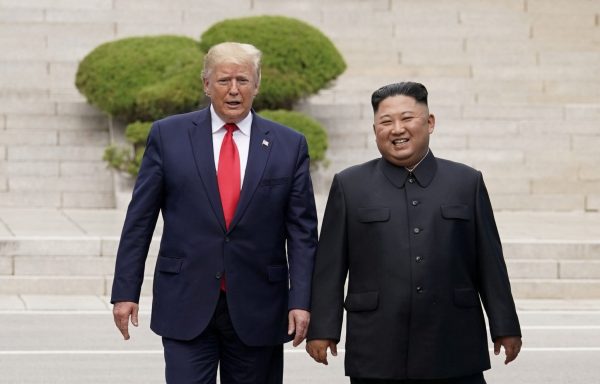Letters between Kim and Trump over the course of June kept a semblance of an open communication channel. Russian President Vladimir Putin and Chinese President Xi Jinping also relayed to Trump the North Korean leader’s desire for further dialogue.
Yet, there has effectively been a six-month freeze in working-level and summit-level talks between Washington and Pyongyang since the breakdown in negotiations during the second Trump–Kim summit in February in Hanoi, Vietnam. During the summit, Trump humiliated Kim by refusing his request to trade activities toward denuclearisation for immediate sanctions relief.
In the months following, purges were reported — North Korea was reported to have executed its nuclear envoy to the United States, Kim Hyok-chol, and dispatched Kim Yong-chol, the counterpart of US Secretary of State Mike Pompeo, to hard labour in a re-education camp. While the accuracy of these reports has been questioned, they underscore the high stakes for the Kim regime. Even South Korean President Moon Jae-in could not break the US–North Korea impasse despite his country’s detente with North Korea that seemed to bear fruit in 2018.
Though Pyongyang has yet to violate its self-declared moratorium on nuclear and intercontinental ballistic missile (ICBM) tests since November 2017, it has renewed pressure on the United States by launching several short-range missiles. In effect, Pyongyang did break the suspension of missile testing of any kind under prevailing UN resolutions.
Yet Trump, in his unorthodox style, pulled off a ‘mini summit’ with a slighted and increasingly bellicose Kim. This was a gamble since there was a chance the North Korean leader would not show up. By established standards of summitry, this was essentially impromptu.
Trump counted on Kim’s impulse that any face-to-face with a US president would generate some meaningful political dividends, rather than any dispassionate calculus focusing on another potential humiliation.
With the mutual agreement to restart working-level discussions regarding North Korea’s denuclearisation, the United States and North Korea are back to where they were between the first and second summits. Washington and Pyongyang are caught in between two frames — the need to get the optics and tone of the relationship that characterised the first summit right and the imperative to close a deal that constituted the second summit.
There are several facets to the Korean Peninsula crisis that put North Korea’s standing with the ‘six parties’ — the United States, South Korea, China, Japan and Russia — at stake. Bilateral and multilateral discussions are required to address the interests of all parties if there is going to be long-term stability in Northeast Asia. Yet, what matters to the Trump administration is the core threat posed by North Korea’s nuclear-tipped ICBMs to the US homeland.
As such, most parties recognise that further progress toward long-term stability on the peninsula is dependent on headway in US–North Korean relations. As one Chinese academic put it bluntly, ‘No third party can be a meaningful mediator in this case. Whether North Korea will eventually proceed with denuclearisation depends entirely on its bilateral negotiations with the United States. The two alone decide outcomes, and neither Beijing nor Seoul can make significant differences’.
While Trump is ‘not looking for speed’ but rather ‘looking to get it right’ in future negotiations, there is an inherent limit on the number of times either side can restart dialogues should there be more breakdowns.
Both sides must start conceding some ground of their own as the trust between Washington and Pyongyang is brittle. This renewed diplomatic exchange may be the final opportunity to produce a denuclearisation agreement that is acceptable to both leaders.
It is increasingly untenable for the Trump administration to want to reward North Korea only after it has achieved denuclearisation, which can be a long and drawn-out process difficult to verify. Similarly, it is untenable for the Kim regime not to dismantle the Yongbyon Nuclear Scientific Research Centre as a significant milestone towards further denuclearisation after offering to do so in prior meetings. Kim has to eventually remove, at least, the ICBM layer of its overall nuclear capabilities that have threatened the US mainland since late 2017.
Back to optics and gestures, President Trump set foot from the DMZ into North Korean territory because he expects Kim to reciprocate by seeing him in the White House. This is a game of quid pro quo, and the waypoints for further progress have now been set for the rest of this year and perhaps the first half of 2020 before the next presidential election.
By that time, it should be clear whether the US–North Korean negotiations will have succeeded in abating the nuclear threat. If no progress is achieved, Trump could well revert to the ‘fire and fury’ brinkmanship of the early days of his administration.
Graham Ong-Webb is an Adjunct Fellow at the S Rajaratnam School of International Studies (RSIS), Nanyang Technological University, Singapore.
An earlier version of the article first appeared here on AsiaGlobal Online.

